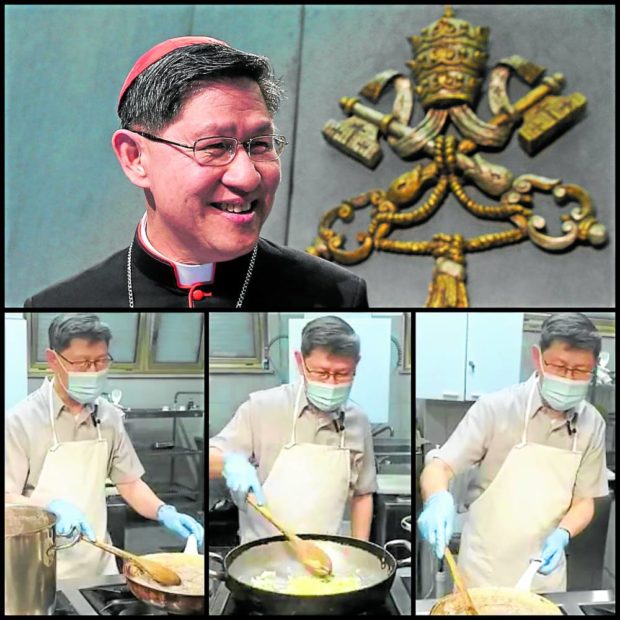
FROM CAVITE TO THE VATICAN Cardinal Tagle cooking Imus delicacies at the Pontificio Collegio Filippino in Rome. —CONTRIBUTED PHOTOS
Pampanga has always been hailed as the food capital of the Philippines. Dining at Bale Dutung, the home of Claude and Maryann Tayag, for an authentic Kapampangan meal has been at the top of every gourmet and gourmand’s to-do list when eating in the Philippines. Even Anthony Bourdain made his way there and praised the food.
Ilonggos and Negrenses, of course, would argue that food from Iloilo and Bacolod is the best. How can you not love inasal, pancit molo, batchoy, binakol and more? Cebuanos would also argue that they have, among other specialties, the best lechon. Then, there are all these delicacies from around the country that make a town or a province a culinary destination: Batac empanada, Bulacan chicharon, pancit Malabon, laing from Bicol, Tausug piyanggang manok, curacha from Zamboanga.
But I must admit I was not familiar with the specialties of Cavite, aside from Amadeo coffee, until my good friend Tata Mapa, who was editor in chief of My Pope magazine (and who left us for heaven just this month—we miss you dearly, Tata!), asked me to write about the food that Cardinal Luis Antonio Tagle, then the Archbishop of Manila, grew up with.
Dining with the Tagles
A few days later, with chef Jessie Sincioco, the personal chef of Pope Francis in Manila, as my guide, I found myself in Imus, Cavite, dining with Cardinal Tagle’s parents, Manuel and Milagros, and Ate Delia, eating pangat na sapsap (poached fish), a Caviteño delicacy. In my maternal hometown of Sta. Maria, Bulacan, we would enjoy pinangat na bisugo, so sapsap was new to me.
Then as I researched, I stumbled upon a cooking show on TV Maria entitled “Tastetimony” where His Eminence cooked another Caviteño dish: adobong tokwa, using a recipe passed down from his paternal grandmother who ran a karinderya (Filipino diner). In another episode, he cooked Tamales, a quintessential Caviteño delicacy.
Two years later, he was appointed by Pope Francis to join the Roman Curia as prefect of the Congregation for the Evangelization of Peoples and he had to move to Rome at the start of the pandemic. But that did not stop him from showcasing Caviteño flavors! He has been regularly holding Sunday mass live from the Our Lady of Peace and Good Voyage Chapel of the Pontificio Collegio Filippino, home to Filipino priests doing further studies in Rome. But after mass, he would personally cook lunch for the priests, who decided to livestream the Cardinal while cooking! In these livestreams, he has cooked pancit pusit (squid ink noodles), adobong Imus and lutong palaka, a kind of frogs legs stew with sigarilyas and patani cooked in garlic, onion, tomato, ginger and achuete oil; mutya ng Cavite, which is their province’s version of bouillabaisse; and longganisang Imus, his hometown’s sausage.
I mention all these as today, Feb. 27, is his presbyteral anniversary, the day he became a priest, 40 years ago! What a journey: from associate pastor in Mendez, Cavite, to Roman Curia at the Vatican … and yet he still found time to showcase Caviteño cuisine!
Thank you, Cardinal Chito, for being not only an ambassador of faith but also an ambassador of Filipino food! May all our diplomats, expats and overseas Filipinos in different parts of the globe be inspired to proclaim faith and Filipino food as you do!
Happy Sacerdotal Anniversary to His Eminence. Here’s to Filipinos and regional Filipino cuisine embodying “magis” around the world! INQ

